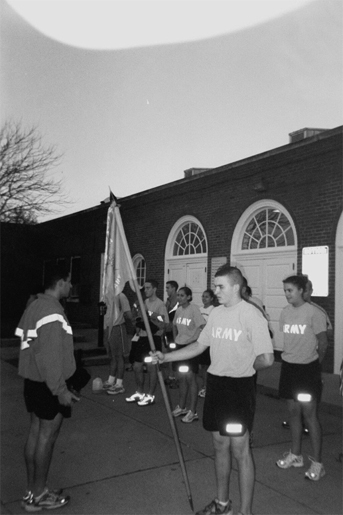|
ARMY ROTC: BEHIND THE CAMO |
||||
|
FEATURE By ROB GARNER The Terrapin Times Staff Writer
Cadets prepare for their two-mile run at Ludwig Field
Uniformed students can be seen all over the Maryland campus.
The basketball team wears uniforms when
it plays at the Comcast Center.
The marching band wears uniforms when it performs
during halftime at Byrd Stadium. The football team
wore uniforms when it beat the Virginia Wahoos last
month.
But these are not the only groups of students
that wear uniforms. Maryland’s Army ROTC cadets
can sometimes be spotted on campus in their battle
dress uniforms (camouflage) or formal uniforms.
Camouflage is worn to ROTC classes and labs, while
the formal uniform is reserved for special occasions.
The ROTC at the University of Maryland,
known as the Terrapin Battalion, trains students to
be second lieutenants in the United States Army,
Army Reserve, and Army National Guard. Cadets
work as a team, in which each individual has the
latitude, encouragement, and assistance to develop
their full leadership potential.
The Terrapin Battalion develops cadet’s
leadership skills by instilling in them the importance
of courage, candor, competence and commitment, by
following its motto, “Live free or die.”
The ROTC allows an individual to join the
Army as a 2nd lieutenant, the lowest commissioned
officer rank, after graduation. If a person wishes to
become an officer without participating in ROTC, he
or she can either go to a military academy or enlist
and eventually attend Officer Candidate School (OCS).
|
One cadet said participation definitely gets you
in shape. Another cadet said before getting involved,
he weighed over 200 pounds. He now weighs about 160.
There is only one disadvantage to the ROTC,
according to cadets. “Just the amount of sleep you can’t
get,” said economics major David Sumutka, who in his
third year with the Terrapin Battalion.
However, Company Commander Christopher
Wei says, “The benefits far outweigh the cost.”
With recent events in Iraq and around the world,
people may think its best to take out their frustrations
with the military on cadets, not realizing that cadets are
not policy-makers, Company Commander Christopher Wei
says.
“But most people walk by and thank [us] for
providing [our] service” Mileva says.
Holly Johnson, a criminology major and
self-described military brat with a family history of military
service, says, “You feel proud of what you are and what
you’re doing.”
The Terrapin Battalion is a fairly young and small
ROTC group. The ROTC is in its third year at Maryland,
and it currently has 48 members. In comparison,
Texas A&M’s Corps of Cadets is over 125 years old and
has about 2,000 members.
James Snoddy, the battalion commander of the
Maryland ROTC believes that the Terrapin Battalion is
more cohesive than larger groups across the country.
Cadets agree their size allows them to be part of a
closely-knit family with excellent camaraderie.
Cadets devote their mornings to physical training (PT). On
Mondays, Wednesdays and Fridays, PT runs from 6:30 a.m.
to 7:30 a.m., unless there is a physical fitness test as there
was Friday, Nov. 21.
On that brisk morning at 5:50 a.m., cadets trickled
into Cole Field House long before the sun rose to test their
strength and endurance.
At 0557, the cry to fall in was given. “Why you
walkin’?” some shouted as the last few cadets got in line.
Cadets began the PT test by measuring their
heights and weights to make sure they meet the Army’s
requirements for body composition. Rick Charette, one
of the cadets, calls it the fat test.
|
|
Push-ups are next. Cadets must do as many as
they can within a two-minute time period. Before
taking the test, one cadet lists the rules about what
push-up positions are valid for the test, what rest
positions are allowed and what movements are
not allowed.
If they fail to follow these rules to the letter,
they are terminated. The test is over for them.
Ryan Conley managed 70 push-ups, one
short of what the Army lists as a score of 100 for
men in Conley’s age bracket. “I sucked” he said.
The minimum passing score for Conley is a 60,
or 42 push-ups.
Cadets then try to complete as many
sit-ups as they can, following rules as stringent as
those for push-ups.
After this rigorous workout, the Terrapin
Battalion marches over to Shipley Field for a two-mile
run. One cadet called the cold ideal weather for
running.
The cadets finished their run, in which,
“13 minutes is a good time.” The sun had just started
to show itself, and the frost blanketing the ground had
just begun to melt. The group of cadets dispersed
with some rushing to get to their 8 a.m. classes on
time.
For all their work, which includes hours of
classroom work as well, freshman and sophomore
cadets get one credit hour per semester. Juniors and seniors get three.
Although students can receive scholarships
and stipends for being in the ROTC, cadets in the
Terrapin Battalion say they do not participate for these
benefits alone. Anelia Mileva, a sophomore hoping to
graduate with a business degree, said, “I don’t feel
like I need a benefit. It’s something that I just really
like to do.”
For more information on the Terrapin Battalion, send email
to umcpgoldbar@hotmail.com or visit The Terrapin
Battalion’s web site at www.armyrotc.umd.edu.
|
|

